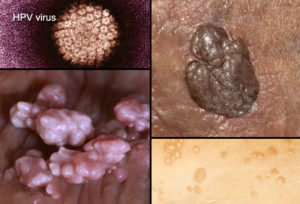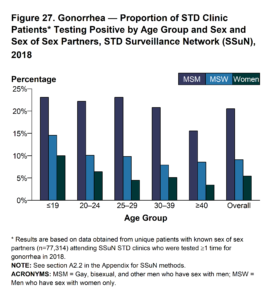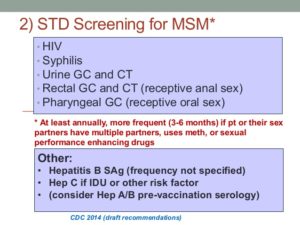Genital warts (or condylomata acuminata, venereal warts, anal warts and anogenital warts)
Genital warts affect both men and women and can occur at any age.
Most patients with genital warts are between the ages of 17-33 years. Genital warts are highly contagious. There is high risk of getting the infection from a single sexual contact with someone who has genital warts.
In children younger than three years of age, genital warts are thought to be transmitted by nonsexual methods such as direct manual contact. Nevertheless, the presence of genital warts in children should raise the suspicion for sexual abuse.
Up to 20% of people with genital warts will have other sexually transmitted diseases (STDs).
Most genital warts are caused by two specific types of the virus (HPV-6 and -11), and these HPV types are considered “low risk,” meaning they have a low cancer-causing potential. Other HPV types are known causes of premalignant changes and cervical cancers in women. HPV16, one of the “high-risk” types, is responsible for about 50% of cervical cancers. HPV types 16, 18, 31, and 45 are other known “high risk” virus types. High-risk HPV types are also referred to as oncogenic HPV types. HPV is believed to cause 100% of cases of cervical cancer..
Genital warts are caused by the human papillomavirus (HPV). Over 100 types of HPVs have been identified; about 40 of these types have the potential to infect the genital area.
Most genital warts are caused by two specific types of the virus (HPV-6 and -11), and these HPV types are considered “low risk,” meaning they have a low cancer-causing potential. Other HPV types are known causes of premalignant changes and cervical cancers in women. HPV16, one of the “high-risk” types, is responsible for about 50% of cervical cancers. HPV types 16, 18, 31, and 45 are other known “high risk” virus types. High-risk HPV types are also referred to as oncogenic HPV types. HPV is believed to cause 100% of cases of cervical cancer.
The viral particles are able to penetrate the skin and mucosal surfaces through microscopic abrasions in the genital area, which occur during sexual activity. Once cells are invaded by HPV, a latency (quiet) period of months to years may occur, during which there is no evidence of infection.
Genital warts are indirectly associated with use of birth control pills due to increased sexual contact without the use of barrier protection, multiple sex partners, and having sex at an early age.
The size may range from less than one millimeter (1 mm = 0.039 inches) across to several square centimeters (1 cm = 0.39 inches) when many warts join together.
Rarely, bleeding or urinary obstruction may be the initial problem when the wart involves the urethral opening (the opening where urine exits the body.)
There may be a history of previous or concurrent sexually transmitted diseases (STDs).In men, genital warts can infect the urethra, penis, scrotum, and rectal area. The warts can appear as soft, raised masses with a surface that can be smooth (on the penile shaft) or rough with many fingerlike projections (anal warts). Others may appear pearly, cauliflower-like, or rough with a slightly dark surface. Most lesions are raised, but some may be flat with only slight elevation above the skin surface. Sometimes lesions may be hidden by hair or in the inner aspect of the uncircumcised foreskin in males.
Diagnosis:
It is often based on findings from the history and appearance of the genital warts. Magnification of the area (colposcopy) using a scope may be necessary to see the lesions. In females, a colposcope may be used to look for lesions in the vaginal canal and on the cervix. A biopsy can be performed if the lesion appears unusual or recurs after treatment. Because genital warts essentially have no symptoms other than their appearance, there is little need for home treatment. It is important, however, to recognize that the warts exist. Be careful to prevent transmission to a sexual partner.
Treatment:
#1 before even getting genital herpes and stick PREVENTION!! Never get them.
Cryotherapy: This technique freezes the wart using liquid nitrogen or a “cryoprobe.” It is an excellent first-line treatment because response rates are high with few side effects.
Electrodesiccation: This technique uses an electric current to destroy the warts. It can be done in the office with local anesthesia. Of note, the resulting smoke plume may be infectious.
Surgery in some cases removing the warts.
Complete the necessary treatment as outlined by your health care practitioner
There is also alternative treatments:
*Types of medical creams prescribed and even OTC. Again please with the all topical creams it is vital to complete the treatment as ordered by your doctor!
*Laser treatment – This treatment is used for extensive or recurrent genital warts. It may require local, regional, or general anesthesia. The laser physically destroys the HPV-induced lesion. Disadvantages include high cost, increased healing time, scarring, and potentially infectious viral particles in the air caused by the laser plume (hydrodynamics).
There is no single effective cure for removal of genital warts. A number of treatment options exist; however, no treatment is 100% effective in eliminating warts and preventing them from coming back in all patients. It also is not possible to eliminate infection with human papillomavirus (HPV) once it has occurred. Genital warts may go away on their own in about 10% to 20% of people over a period of three to four months.
Things you should also know:
- Because the warts themselves are infectious, avoid touching them. Do not pick or squeeze the warts.
- Take the necessary precautions to prevent trauma to the area, which can result in bleeding.
- Special laboratory tests can also be used to confirm the presence of HPV infection.
- A routine Pap smear should always be done in order to look for evidence of HPV infection and abnormal cells on the cervix.
- Sometimes, lesions are only visible with an enhancing technique called acetowhitening. This technique involves the application of 5% acetic acid solution to the area of suspicion for about 5-10 minutes. Infected areas will turn white.
- In women, genital warts have a similar appearance and usually occur in the moist areas of the labia minora and vaginal opening. Lesions visible on the outer genitals warrant a thorough examination of the vaginal canal, cervix, and anorectal area. Most vaginal warts occur without symptoms.
- Rarely, women may experience bleeding after sexual intercourse, itching, or vaginal discharge.
- Specific descriptions
- Warts in more than one area are common.
- Men and women with genital warts will often complain of painless bumps, itching, and discharge.
- Signs or genital warts: First know although genital warts are painless, they may be bothersome because of their location, size, or due to itching.
- Generally, about two-thirds of people who have sexual contact with a partner who has genital warts develop them within three months.
- Common warts are not the same as genital warts and are caused by different HPV types that infect the skin.



